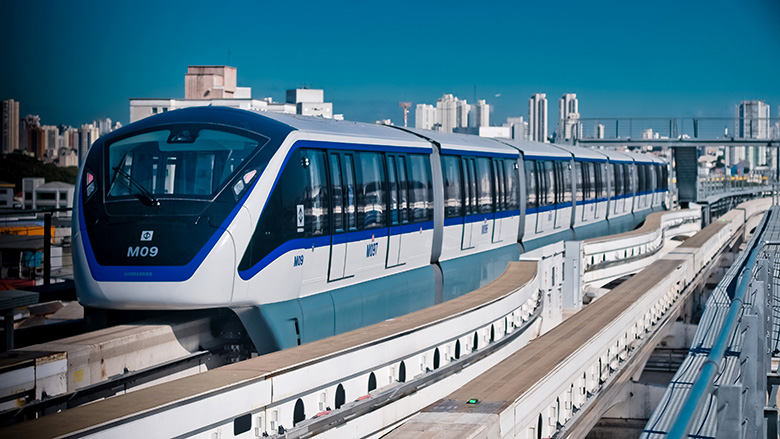Results
By supporting the construction, train acquisition, and installation of systems for Metro Line 5, the project improved the mobility of public transport users along the Line 5 corridor. Metro Line 5 is now one of the most modern metro lines in Latin America due to several innovations including (i) the Communications-Based Train Control system, which automates communications between trains and track, resulting in more efficient and safer rail traffic management; and (ii) numerous service-enhancing features, including low noise levels, air conditioning, universal accessibility for persons with disabilities, high energy efficiency in stations, CCTV cameras in all trains, station monitoring from a dedicated control center, and platform doors that open when the train arrives to enhance safety, speed, and regularity in boarding times. The following key outcomes were supported by this project:
Travel and waiting time for public transport from Largo Treze (the last station on Line 5 before the extension) to Chácara Klabin (the last station on Line 5 after the extension) dropped from 72 minutes in 2010, before the project, to 26 minutes in 2020.
Travel and waiting time between Capão Redondo, the first station on Line 5, to Sé, a station in the central business district, crossing all new Line 5 stations and connecting with Line 1, has halved, dropping from 99 minutes before the project to 50 minutes after the project.
Prior to the COVID-19 pandemic, about 58 % of all trips on Line 5 were by low-income passengers (from households that earn less than four monthly minimum salaries), with an average daily ridership among these users of 329,000 in 2019.
User surveys in 2019 showed that 84 % of all users perceived Line 5 performance as satisfactory.
Five stations on Line 5 have adjacent bus terminals, allowing passengers to transfer directly from or to buses, supporting seamless transfers within the public transport network.
Gross greenhouse gas (GHG) emission savings resulting from Line 5 over the economic lifetime of the assets are estimated to be 2,960,000 tCO2eq, including savings from the modal shift away from more GHG-intensive travel modes, such as automobiles and buses, to the metro. Economic benefits related to GHG emissions savings are expected to amount to US$75.6 million over 50 years.
Bank Group Contribution
The World Bank, through the International Bank for Reconstruction and Development, provided a loan in the amount of US$650 million to the State of São Paulo to help finance the project. Of this US$650 million, US$400 million financed rolling stock, system installation, and technical assistance for Line 5, and US$250 million financed the remaining works of Phase 2 of the Line 4 extension, including civil works in Vila Sônia station.
Partners
The solid relationship between the World Bank and the State of São Paulo, the São Paulo State Secretariat for Metropolitan Transport, and Metrô contributed to the project’s successful implementation, building on the more than 25 years of World Bank support for urban transport investments and reforms in the São Paulo metropolitan area. The total costs of Line 5 are estimated at about US$3.7 billion. Other development partners providing co-financing to the Line 5 extension included the Brazilian Development Bank (BNDES), with US$1.9 billion, and the Inter-American Development Bank (IADB), with US$350 million. The Japan Bank for International Cooperation (JBIC) provided co-financing of US$130 million for the second Phase of Line 4. Moreover, both lines are currently operated by the private sector, which has committed to investing about US$2 billion in Line 4 and US$3 billion in Line 5 over the span of the concession periods of 30 and 20 years, respectively.
Beneficiaries
The extension of Line 5 in São Paulo has improved mobility for thousands of passengers—in 2019, this meant, on average, 563,000 passengers every day, of which 56 % were women and 58 % were from low-income households (earning less than four monthly minimum salaries). The entire population of São Paulo (more than 22 million people) now benefits from better rail transport and from Line 5’s effect in lowering GHG emissions by providing a high-quality alternative to more polluting travel modes, such as automobiles and motorcycles.
As described by one Line 5 user, her travel time to work has been significantly reduced with the opening of the new stations, and she has shifted away from using automobile and bus travel, avoiding the heavy traffic congestion in the city.
Moving Forward
Post–COVID-19, the high-quality service provided by the Line 5 extension will contribute to rebuilding the public’s confidence in mass transport while addressing customers’ health and safety concerns. Future expansion of the metro network is expected to bring additional passengers onto Line 5, including a second expansion of the metro line that will provide accessibility to low-income populations in the vicinity of two new stations, Comendador Sant’Anna and Jardim Ângela. This later extension is expected to be financed by the private concessionaire in charge of Line 5 operations.
